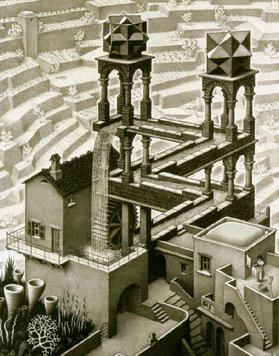Commonly referred to as the “Penrose Triangle” or “Impossible Triangle”, this is another variation of the impossible triangle first created by Oscar Reutersvärd in 1934. The name “Penrose Triangle” came from an article published in the British Journal of Psychology Psychology in 1958 by Roger and Lionel Penrose which popularized the illusion. At the time, the Penrose’s were unaware of Oscar Reutersvärd’s work. The article was inspired by a lecture by dutch artist M.C. Escher, who had yet to create his three most famous impossible prints (Belvedere, Ascending and Descending, and Waterfall). After the article was published, a copy was sent to Escher, who used it as inspiration for Waterfall. In Waterfall, two connected Penrose Triangles form the aqueduct that appears to lead water from the bottom of the waterfall back to the top.
